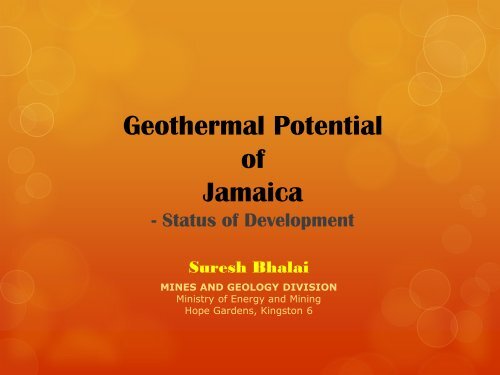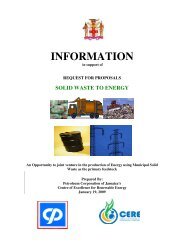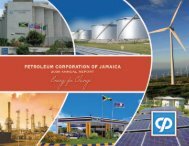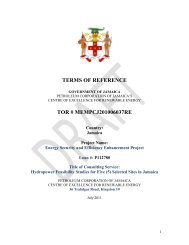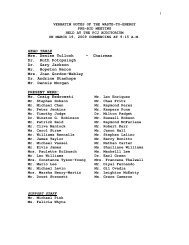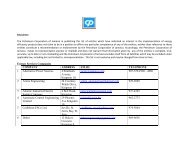Geothermal Potential of Jamaica
Geothermal Potential of Jamaica
Geothermal Potential of Jamaica
You also want an ePaper? Increase the reach of your titles
YUMPU automatically turns print PDFs into web optimized ePapers that Google loves.
<strong>Geothermal</strong> <strong>Potential</strong><br />
<strong>of</strong><br />
<strong>Jamaica</strong><br />
- Status <strong>of</strong> Development<br />
Suresh Bhalai<br />
MINES AND GEOLOGY DIVISION<br />
Ministry <strong>of</strong> Energy and Mining<br />
Hope Gardens, Kingston 6
OUTLINE<br />
GEOTHERMAL ENERGY?<br />
<strong>Geothermal</strong> Resource vs Conventional Power Resources<br />
Current Production Methods<br />
JAMAICA - GEOTHERMAL ENVIRONMENT<br />
Geology<br />
Status <strong>of</strong> geothermal development<br />
Exploration guides<br />
Further exploration<br />
Known areas<br />
Exploitation technique<br />
Some considerations – benefits and barriers
GEOTHERMAL<br />
ENERGY?<br />
<strong>Geothermal</strong>: „geo‟ = earth; „thermal‟ = heat<br />
“heat from the earth”<br />
Earth abounds in thermal energy.<br />
Heat generated from breakdown <strong>of</strong> naturally occurring<br />
radioactive materials.<br />
Heat is present everywhere beneath the surface.<br />
Heat rises to the surface and escapes to the<br />
atmosphere.<br />
„Renewable‟ OR Sustainable?
? ? ? ?<br />
<strong>Geothermal</strong> environments:<br />
High- and moderate-temperature rocks with considerable<br />
available water and (or) steam are the only geothermal<br />
environments that can currently be developed to generate<br />
electricity.
<strong>Geothermal</strong> Energy<br />
as a<br />
Resource
<strong>Geothermal</strong> Energy as a Mineral Resource<br />
SIMILARITIES<br />
Occur everywhere,<br />
Anomalous concentrations are favourable,<br />
Have measurable GRADE and SIZE<br />
Economic deposits – those at depths accessible by<br />
current extraction technology while remaining cost<br />
efficient.<br />
80°C 180°C<br />
LOW GRADE MEDIUM GRADE HIGH GRADE
<strong>Geothermal</strong> Energy as a Mineral Resource<br />
CHARACTERISTICS MINERAL RESOURCES GEOTHERMAL ENERGY<br />
Extractive process<br />
digging, crushing and<br />
processing <strong>of</strong> large quantities<br />
<strong>of</strong> earth material<br />
Liquid<br />
(brought to surface by hot<br />
springs or wells)<br />
Extractive method<br />
Economic characteristics<br />
mine shafts, tunnels, pits and<br />
spoil heaps<br />
Size and/or grade determines<br />
pr<strong>of</strong>itability and efficiency <strong>of</strong><br />
operation<br />
Drilled wells<br />
Usable over a very wide<br />
spectrum <strong>of</strong> temperature and<br />
volume
<strong>Geothermal</strong> Energy vs Conventional Power Resources<br />
Environmentally benign – low emission<br />
• Hot water and steam plant:
<strong>Geothermal</strong> Energy vs Conventional Power Resources<br />
CO 2 EMISSIONS<br />
Similar contrasts for the emission <strong>of</strong> sulphurous gases
<strong>Geothermal</strong> Energy vs Conventional Power Resources<br />
RELIABILITY<br />
Once online geothermal power plants are very reliable<br />
Off-line ~5% (avg.) <strong>of</strong> the time.<br />
CLIMATE CHANGE<br />
<strong>Geothermal</strong> energy is an environmentally-friendly option.
Current Production Methods<br />
Hot Water<br />
Hydrothermal System<br />
Vapour-dominated<br />
Hydrothermal System<br />
Moderate Temperature<br />
Hydrothermal System
STATUS OF GEOTHERMAL<br />
DEVELOPMENT IN JAMAICA<br />
HISTORY/ STATUS OF DEVELOPMENT<br />
Late 1600s: Bath, St. Thomas,<br />
Mid-1700s: Milk River Bath<br />
1950s – Geological Survey Department<br />
1980s:<br />
• Preliminary examinations<br />
• OLADE – Latin American Energy Organization, 1982<br />
• Ittracon – 22 Springs in tourist areas<br />
• Occidental <strong>Geothermal</strong> Inc. – Blue Mountain area<br />
• Geological Survey Division<br />
OLADE Summary report available.
<strong>Jamaica</strong>n Geology
JAMAICAN GEOLOGY<br />
JAMAICA - >65 million years ago
JAMAICA - TODAY
JAMAICA - STRUCTURE
Exploration Guides
EXPLORATION GUIDES
EXPLORATION GUIDES<br />
Position on the<br />
Caribbean Plate<br />
= low –<br />
moderate<br />
resources
EXPLORATION GUIDES<br />
Hot/ warm<br />
springs<br />
<strong>Potential</strong>ly<br />
water-bearing<br />
rocks and<br />
structures<br />
GEOTHERMAL<br />
RESOURCES<br />
Subsurface<br />
temperature<br />
anomalies<br />
Seismic zones
POTENTIAL AREAS:<br />
<br />
<br />
EXPLORATION<br />
GUIDES<br />
Faulted rocks older than the White Limestone,<br />
Boundary between different older rocks,<br />
especially intrusive igneous rocks.<br />
Shale<br />
White<br />
Limestone<br />
Yellow<br />
Limestone<br />
Sandstone<br />
Dacite<br />
Conglomerate<br />
Granodiorite<br />
Andesite<br />
Marble<br />
Serpentinite
# NAME TEMP<br />
°C<br />
FLOW<br />
litres/sec<br />
EXPLORATION<br />
GUIDES<br />
1 Guava River Spring 53 0.3<br />
2 Bath Spring 54 0.3<br />
3 Mt. Felix Spring 31 0.3<br />
4 Garbrand Hall Spring 29 1.5<br />
5 Rockfort Spring 30 50<br />
7 Salt River Spring 33 100 – 200<br />
8 Milk River Springs 38 40 – 50<br />
9 Black River Spring 29 45 – 50<br />
10 Windsor Spring 36 0.5<br />
10<br />
11 Yankee River Spring 26 0.5<br />
12<br />
12 Buxton Spring 29 1.2<br />
11<br />
2<br />
9<br />
4<br />
8<br />
7<br />
3<br />
6<br />
5<br />
1<br />
4<br />
1<br />
3<br />
2
EXPLORATION GUIDES<br />
LIMITATION:<br />
Low possibility <strong>of</strong> abnormally high<br />
heat flow,<br />
Little information on geothermal<br />
gradients,<br />
Low flow rates,<br />
Contamination by seawater<br />
# NAME TEMP<br />
°C<br />
1 Guava River Spring 53 0.3<br />
2 Bath Spring 54 0.3<br />
3 Mt. Felix Spring 31 0.3<br />
4 Garbrand Hall Spring 29 1.5<br />
5 Rockfort Spring 30 50<br />
FLOW<br />
litres/sec<br />
7 Salt River Spring 33 100 – 200<br />
8 Milk River Springs 38 40 – 50<br />
9 Black River Spring 29 45 – 50<br />
10 Windsor Spring 36 0.5<br />
11 Yankee River Spring 26 0.5<br />
12 Buxton Spring 29 1.2
EXPLORATION<br />
TECHNIQUE<br />
Binary systems would be<br />
most suitable<br />
Waterbearing<br />
rocks and<br />
structures
Some Considerations
SOME<br />
CONSIDERATIONS<br />
EXPLORATION PROGRAM:<br />
Joint Government-Private coupled program,<br />
Successful in the USA,<br />
Local knowledge combined with experience,<br />
Reduces financial and discovery risks associated with<br />
exploration,<br />
Research direction: develop techniques and strategies to<br />
identify hidden systems at greater depths.
SOME<br />
CONSIDERATIONS<br />
CHALLENGES:<br />
Are our resources within economically drillable depths?<br />
What is the state <strong>of</strong> the subsurface energy system?
REFERENCES<br />
Duffield, W. A. and Sass, J. H., 2003, <strong>Geothermal</strong> Energy –<br />
Clean Power from the Earth‟s Heat. U. S. Geological Survey,<br />
Virginia, Circular 1249, 36pp.<br />
Hylton, H. A., 1987, Mineral Springs <strong>of</strong> <strong>Jamaica</strong>. Geological<br />
Survey Division, Kingston Bulletin No. II, 69pp.<br />
<strong>Jamaica</strong> Public Service, 2007, JPS – An Overview. JPS,<br />
Kingston, unpublished report, 14pp.<br />
Latin American Energy Organization, 1982, <strong>Geothermal</strong><br />
Resource Exploration, Reconnaissance, Review and<br />
Utilisation Report. Geological Survey Division, Kingston,<br />
unpublished report, 169pp.


